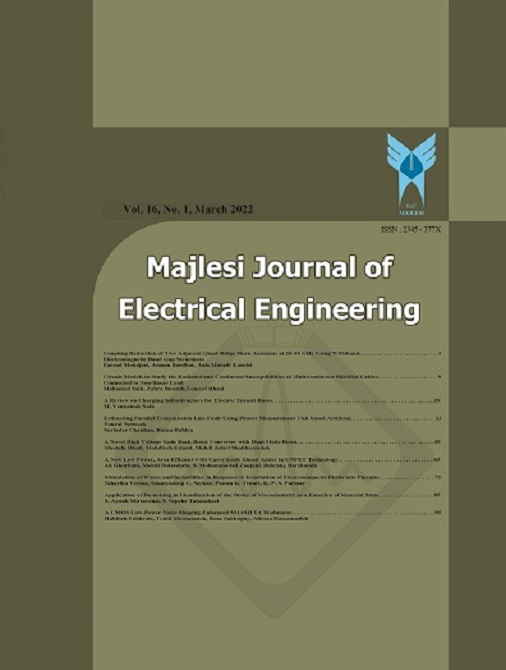[1] O. Ellabban and H. Abu-Rub, “Z-Source Inverter: Topology Improvements Review,” IEEE Industrial Electronics Magazine, vol. 10, no. 1, pp. 6–24, Mar. 2016, doi: 10.1109/MIE.2015.2475475.
[2] M. Trabelsi, H. Vahedi, and H. Abu-Rub, “Review on Single-DC-Source Multilevel Inverters: Topologies, Challenges, Industrial Applications, and Recommendations,” IEEE Open Journal of the Industrial Electronics Society, vol. 2, pp. 112–127, 2021, doi: 10.1109/OJIES.2021.3054666.
[3] R. A. Rana, S. A. Patel, A. Muthusamy, C. woo Lee, and H.-J. Kim, “Review of Multilevel Voltage Source Inverter Topologies and Analysis of Harmonics Distortions in FC-MLI,” Electronics, vol. 8, no. 11, Art. no. 11, Nov. 2019, doi: 10.3390/electronics8111329.
[4] F. K. Mohideen, N. A. M. Kajaan, Z. M. Isa, N. M. Nayan, M. H. Arshad, and S. S. Saad, “THD analysis for symmetrical five level and seven level cascaded multilevel inverter,” J. Phys.: Conf. Ser., vol. 1432, no. 1, p. 012020, Jan. 2020, doi: 10.1088/1742-6596/1432/1/012020.
[5] S. Shuvo, E. Hossain, T. Islam, A. Akib, S. Padmanaban, and Md. Z. R. Khan, “Design and Hardware Implementation Considerations of Modified Multilevel Cascaded H-Bridge Inverter for Photovoltaic System,” IEEE Access, vol. 7, pp. 16504–16524, 2019, doi: 10.1109/ACCESS.2019.2894757.
[6] M. A. Hosseinzadeh, M. Sarebanzadeh, E. Babaei, M. Rivera, and P. Wheeler, “A Switched-DC Source Sub-Module Multilevel Inverter Topology for Renewable Energy Source Applications,” IEEE Access, vol. 9, pp. 135964–135982, 2021, doi: 10.1109/ACCESS.2021.3115660.
[7] Y. Wang, J. Ye, R. Ku, Y. Shen, G. Li, and J. Liang, “A modular switched-capacitor multilevel inverter featuring voltage gain ability,” J. Power Electron., vol. 23, no. 1, pp. 11–22, Jan. 2023, doi: 10.1007/s43236-022-00508-9.
[8] A. Vijayakumar, A. A. Stonier, G. Peter, A. K. Loganathan, and V. Ganji, “Power quality enhancement in asymmetrical cascaded multilevel inverter using modified carrier level shifted pulse width modulation approach,” IET Power Electronics, vol. n/a, no. n/a, doi: 10.1049/pel2.12429.
[9] V. Kubendran, Y. Mohamed Shuaib, S. Vidyasagar, V. Kalyanasundaram, and K. Saravanan, “The development of a generalized multilevel inverter for symmetrical and asymmetrical dc sources with a minimized ON state switch,” Ain Shams Engineering Journal, vol. 15, no. 2, p. 102358, Feb. 2024, doi: 10.1016/j.asej.2023.102358.
[10] F. L. Luo, “Investigation on best switching angles to obtain lowest THD for multilevel DC/AC inverters,” in 2013 IEEE 8th Conference on Industrial Electronics and Applications (ICIEA), Jun. 2013, pp. 1814–1818. doi: 10.1109/ICIEA.2013.6566663.
[11] S. T. Meraj, N. Z. Yahaya, K. Hasan, and A. Masaoud, “A hybrid T-type (HT-type) multilevel inverter with reduced components,” Ain Shams Engineering Journal, vol. 12, no. 2, pp. 1959–1971, Jun. 2021, doi: 10.1016/j.asej.2020.12.010.
[12] M. N. Hamidi, D. Ishak, M. A. A. M. Zainuri, and C. A. Ooi, “Multilevel inverter with improved basic unit structure for symmetric and asymmetric source configuration,” IET Power Electronics, vol. 13, no. 7, pp. 1445–1455, May 2020, doi: 10.1049/iet-pel.2019.0916.
[13] A. Srivastava, A. Chauhan, and A. Tripathi, “Design and performance evaluation of a novel modular asymmetrical multilevel inverter with minimal switches,” e-Prime - Advances in Electrical Engineering, Electronics and Energy, vol. 9, p. 100733, Sep. 2024, doi: 10.1016/j.prime.2024.100733.
[14] P. L. Kamani and M. A. Mulla, “Middle-Level SHE Pulse-Amplitude Modulation for Cascaded Multilevel Inverters,” IEEE Transactions on Industrial Electronics, vol. 65, no. 3, pp. 2828–2833, Mar. 2018, doi: 10.1109/TIE.2017.2742990.
[15] D. Gireesh Kumar et al., “Design of an Optimized Asymmetric Multilevel Inverter with Reduced Components Using Newton-Raphson Method and Particle Swarm Optimization,” Mathematical Problems in Engineering, vol. 2023, p. e9966708, Apr. 2023, doi: 10.1155/2023/9966708.
[16] M. Khizer, S. Liaquat, M. F. Zia, S. Kanukollu, A. Al-Durra, and S. M. Muyeen, “Selective Harmonic Elimination in a Multilevel Inverter Using Multi-Criteria Search Enhanced Firefly Algorithm,” IEEE Access, vol. 11, pp. 3706–3716, 2023, doi: 10.1109/ACCESS.2023.3234918.
[17] M. Ali, F. S. Al-Ismail, M. M. Gulzar, and M. Khalid, “A review on harmonic elimination and mitigation techniques in power converter based systems,” Electric Power Systems Research, vol. 234, p. 110573, Sep. 2024, doi: 10.1016/j.epsr.2024.110573.
[18] P. R. Bana, K. P. Panda, R. T. Naayagi, P. Siano, and G. Panda, “Recently Developed Reduced Switch Multilevel Inverter for Renewable Energy Integration and Drives Application: Topologies, Comprehensive Analysis and Comparative Evaluation,” IEEE Access, vol. 7, pp. 54888–54909, 2019, doi: 10.1109/ACCESS.2019.2913447.
[19] D. Prasad, C. Dhanamjayulu, S. Padmanaban, J. B. Holm-Nielsen, F. Blaabjerg, and S. R. Khasim, “Design and Implementation of 31-Level Asymmetrical Inverter With Reduced Components,” IEEE Access, vol. 9, pp. 22788–22803, 2021, doi: 10.1109/ACCESS.2021.3055368.
[20] M. He, M. Liu, R. Wang, X. Jiang, B. Liu, and H. Zhou, “Particle swarm optimization with damping factor and cooperative mechanism,” Applied Soft Computing, vol. 76, pp. 45–52, Mar. 2019, doi: 10.1016/j.asoc.2018.11.050.
[21] C. Y. H’ng, B. Ismail, M. Isa, and M. N. K. H. Rohani, “Selective Harmonic Elimination Pulse Width Modulation for Five-Level Cascaded Inverter,” Journal of Telecommunication, Electronic and Computer Engineering (JTEC), vol. 10, no. 1–14, pp. 67–71, May 2018.
[22] V. Padmathilagam and Natarajan s, p, “Solutions to the harmonic elimination problem in a seven level inverter,” International Journal of Power Electronics, vol. 1, Jan. 2009, doi: 10.1504/IJPELEC.2009.023623.
[23] W. A. Halim, T. N. A. T. Azam, K. Applasamy, and A. Jidin, “Selective Harmonic Elimination Based on Newton-raphson Method for Cascaded H-bridge Multilevel Inverter,” International Journal of Power Electronics and Drive Systems (IJPEDS), vol. 8, no. 3, Art. no. 3, Sep. 2017, doi: 10.11591/ijpeds.v8.i3.pp1193-1202.

